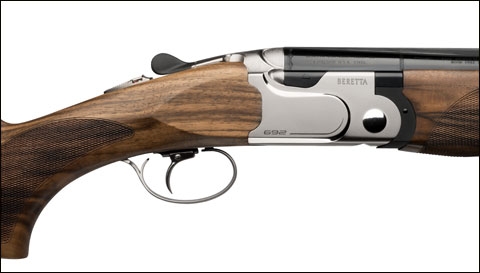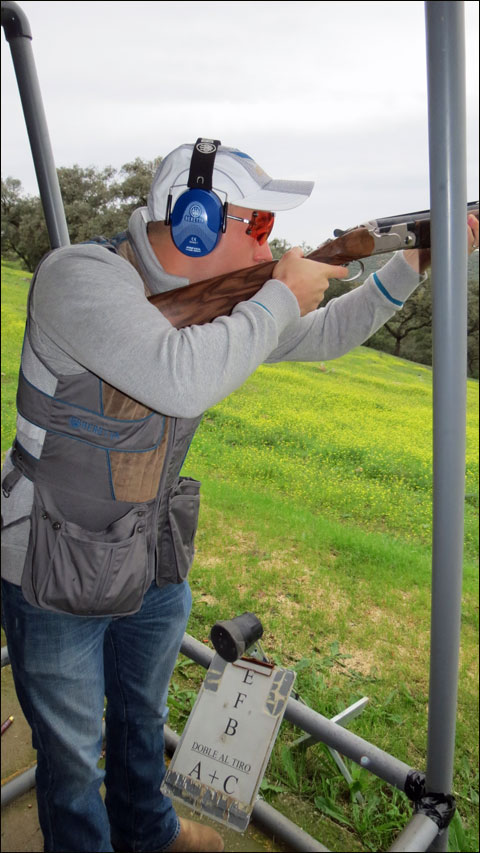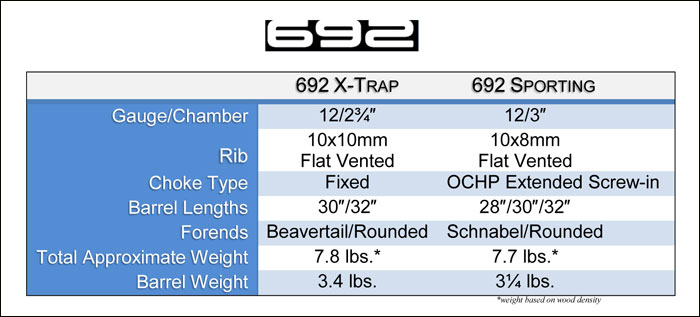New Beretta 692 Leapfrogs to the Top of Mid-Priced Clays Guns

If you’re a fan of disco, the shuttle ride from the airport in Seville, Spain to the historic Hotel Alfonso XIII in the heart of the city got an upbeat start as the gray-haired bus driver played the Pointer Sisters’ “I’m so Excited” on the radio.
The song’s title augured the impending enthusiasm by the cadre of international media flown in by Beretta for the official introduction of the 692 over/under competition shotgun.
Several 692 Sporting models were available for five-stand and bunker-trap evaluations with a number of Spain’s top clays competitors on hand along with American Olympic skeet gold medalist, Vincent Hancock. After a day of experiencing the Beretta 692 at the La Almenara shooting range in Burguillos, conversations with other writers during bus rides, cocktails and dinner were complimentary of the shotgun that consistently broke challenging targets. Maybe many of the reporters were good shots. Nonetheless, you couldn’t ignore the reckoning delivered by the Beretta 692 during an afternoon barrage of targets blown to smithereens at La Almenara.
 Olympic gold medal champion, Vincent Hancock, shooting a Beretta 692 at the La Almenara shooting range.
Olympic gold medal champion, Vincent Hancock, shooting a Beretta 692 at the La Almenara shooting range.As the reporters discovered, you would be hard-pressed not to be excited about shooting the Beretta 692. In the premium price category of $5,000 to $7,000 it emerged as the most neutral handling and accurate clays gun in the segment — exerting considerable pressure on similarly equipped models from Blaser and Zoli. Because it’s a high-volume shotgun, the Beretta 692 is ranked below the premium Krieghoff K-80 and Perazzi MX8 and MX2000. Nonetheless, the shooting dynamics and quality of the Beretta 692 could exert upward market-share creep on those two winner’s circle regulars as progress in computerized rendering and manufacturing erode established value gaps.
From a historical perspective, the Beretta 692 is the successor to the popular Beretta 682, which has sold some 50,000 units since its introduction in the mid-1980s. Looking into the future, however, the Beretta 692 is more than a simple nomenclature enhancement to the 682. In addition to a catalog of new engineering goodies, the 692 redoubles a sleek design DNA for Beretta competition shotguns unveiled in July 2012 with the mighty DT11 clays pulverizer. Partial credit for the new look and feel of the Beretta 692 goes to the brainy folks at Porsche Design.
 The lodge at the La Almenara shooting grounds in Burguillos, Spain.
The lodge at the La Almenara shooting grounds in Burguillos, Spain.But when it comes to pushing the price/performance envelope, Beretta has leveraged economies-of-scale from the costlier DT11 as well as the 682 to sell the 692 at only 3% to 5% higher than the outgoing 682 Sporting, which sold for about $4,500, while the trap single model cost approximately $4,800. Bottom line: when the Beretta 692 arrives in the U.S. during Q1 2013, $5,000 will buy you a state-of-the-art Beretta clays gun that rivals the Blaser F3 Competition Sporting Standard at about $6,500 and the Zoli Z-Sport Bilanx at some $6,000. The repercussions for Blaser and Zoli could intensify when you tally Beretta’s vast marketing and dealer resources. Regardless, it’s all good news for clays enthusiasts ready for a new, shiny shotgun.
 The Beretta 692.
The Beretta 692. While Beretta hails the 692 as a “totally new shotgun,” that’s not entirely precise. The Beretta 692 uses the selective mechanical trigger group of its 682 forerunner, which had a smooth, unobtrusive pull of 3½ to 4 pounds. Otherwise, the Beretta 692 is a smorgasbord of innovation.
For starters, the Beretta 692 steel receiver is an immediate signal that the 682 aesthetic has been relegated to yesteryear. The concentric waves engraved on 682’s matte gray background have been streamlined by the embossed, blunt-nosed contour of a 600 Nitro Express bullet that made its debut on the silvery DT11. The blocky gold markings on the 682 were replaced with black gold on the 692’s burnished receiver. Beretta also added a black composite opening lever with a soft-touch polymeric insert.
Beneath the cosmetics, though, the extra width of the Beretta 692 receiver is trickier to detect — until you start breaking the screamers thrown at the La Almenara five stand. At 1.63 inches, the Beretta 692 receiver is now 1/20th of an inch wider than the 682 Gold. Does the added width really make that much of a difference in terms of shooting? Hard to say, other than the Beretta 692 felt ergonomic, nimble and responsive — certainly less clunky in the hands than the marginally wider Blaser F3 Competition Sporting Standard or Zoli Z-Sport Bilanx at approximately 1¾ inches. The 692 receiver was communicative during the swing, enabling speedy corrections. Beretta described their wider receiver as delivering high stability, improved balance and more precise handling. The company seemed to make good on those claims.
In consideration of the wider receiver and latest barrel technology, it’s readily apparent that the company has positioned the Beretta 692 between the defunct 682 and new DT11 — not just a 682 replacement. While the 692 receiver is 1.63 inches wide compared with 1.58 inches for the 682 and 1.69 inches for the DT11, a peek into the forcing cone technology reinforces Beretta’s product hierarchy.
 You can see the sleek receiver makeover and black composite opening lever of the Beretta 692.
You can see the sleek receiver makeover and black composite opening lever of the Beretta 692.In Beretta’s parlance, it’s the difference between “Good” (682), “Better” (692) and “Best” (DT11).
When Beretta introduced the DT11 in July 2012, the shotgun’s new Steelium Pro barrels took center stage. Steelium Pro is the next-generation of Steelium composite used in Beretta barrels since 2009 for the DT10, 686 Evo and A400 semi-autos. Steelium Pro enabled Beretta to elongate the forcing cones and eliminate the typical bottleneck in the transition from the monobloc. The longer forcing cones moderated felt recoil, muzzle jump and shot deformation, according to Beretta.
 A comparison of forcing-cone lengths in Beretta’s DT11, 692 and 682 as relating to their paradigm of Good, Better and Best.
A comparison of forcing-cone lengths in Beretta’s DT11, 692 and 682 as relating to their paradigm of Good, Better and Best. Now a Steelium variant called Steelium Plus is introduced on the Beretta 692. Although it has the same metallurgical properties at Steelium Pro, the forcing cone length of 14 inches falls between the 682 (2½ inches) and DT11 (19 inches). Like Steelium Pro, the 692 Steelium Plus barrels are deep-drilled, cold-hammer forged and undergo a special vacuum distension that restores the alloy’s original characteristics after the correct bore diameter is achieved during manufacturing. Although the barrels for both the DT11 and 692 are made on the same assembly line, the extra time required by the cold-hammer mandrill to create the longer forcing cone of the DT11 contributes to an appreciably higher cost of production.
The benefits of Steelium Plus became clearly evident during bunker trap. The barrel/target relationship to the outgoing birds was easy to identify and maintain. Very little target float or lead was required — implying stringent barrel regulation. Moreover, when you missed a target on the first shot, the second shot usually nailed the fast-moving bird at 40 yards or more. It was nearly impossible for me to miss any bunker-trap targets until late in the afternoon when I got wacked by a sudden bout of jet lag and retired the Beretta 692.
In terms of reduced felt recoil, I can say unequivocally that the 12-gauge Beretta 692 produced virtually none while shooting the 1-ounce, #7½, 2¾-inch shells rated at 1,150 fps that were provided to us. In my summer-weight shooting shirt, neither shoulder nor cheek was worse for wear after the estimated 125 rounds I fired that day. I would be interested in seeing how the gun performed by upping the ante to the 1⅛ ounce loads typically sold as low-cost price leaders by WalMart and other big-box retailers.
 Shooting the Beretta 692 on the La Almenara five stand. The woman pulling targets, Carolina Barroso, later sang traditional Spanish copla songs on the porch of the lodge.
Shooting the Beretta 692 on the La Almenara five stand. The woman pulling targets, Carolina Barroso, later sang traditional Spanish copla songs on the porch of the lodge.Beretta’s ability to tame recoil on the 692 resulted from a holistic design rather than concentrating only on forcing-cone refinements. While we know that a heavier shotgun sops up recoil, weight distribution is equally critical. A shotgun that achieves ideal balance will swing well, successfully manage muzzle jump (a form of recoil) and evenly disperse backpressure after the shell is discharged.
High-priced competition shotguns such as the DT11, K-80 and MX-8 leave the factory individually balanced to their own characteristics. From the perspective of the manufacturer, these shotguns don’t need the balancing accessories we find in the mid-range Beretta 692, Blaser F3 Competition Sporting Standard or the Zoli Z-Sport Bilanx. It’s like a three-star restaurant that doesn’t leave salt, pepper or ketchup on the table.
Beretta adopted the DT11 B-FAST (“Beretta Fast Adjustment System Technology”) methodology to the 692. Although DT11 B-FAST version doesn’t use balancing weights in the stock, Beretta employs them in the 692. Like the Blaser F3 counter-weight option in the stock, the 692 B-FAST module is comprised of individual weights that can be moved fore and aft along a bolt in the stock. While this type of device is nothing new, B-FAST facilitates the DT11 practice of individually balancing each 692 before it ships, while also allowing the owner to add, subtract or redistribute each of the 7-to-10 ounce washers for a maximum 3½ ounces of rear ballast. By comparison, the Zoli Z-Sport Bilanx installs a similar balance mechanism in the pistol grip called Between Hands Balancer or BHB, which is supplemented by barrel weights and has received industry kudos.
 This slide from a PowerPoint presentation by a Beretta executive at the 692 launch details the B-FAST weight balance system in the stock.
This slide from a PowerPoint presentation by a Beretta executive at the 692 launch details the B-FAST weight balance system in the stock.At La Almenara, the four different 692s that I shot felt impeccably balanced and inherently eager to seek out targets. There were no pressure points in the wrist, fingers or neck that can occur when shooting a gun that requires you to compensate for its shortcomings. Later that night, at the Hacienda Elvizir, standing before a blazing fire pit while drinking sangria and nibbling on appetizers, English writer and clays instructor Michael Yardley described the Beretta 692 to me as “willing” and “without vices.” I would have to agree.
Beretta took a clever turn with the B-FAST balancer. It’s placed deep enough in the cavity to effectively shorten the stock if necessary (excellent news for the ladies). Beretta noted the entire balancing module can also be repurposed for custom stocks —applicable to the Blaser F3 and Zoli arrangements too. The 692 B-FAST balancer is also installed as far back as viable from the central hinge pin so that a minimum amount of tweaking will exert maximum counter-balance results.
On the Beretta 692, B-FAST also encompasses stock and rib tuning. The adjustable comb relies on an underlying apparatus of steel and aluminum for height, drop and cast. This is a dramatic upgrade over the plastic guts used for years on other Beretta shotguns with adjustable combs.
The 692 X-Trap gun is slated for the B-FAST adjustable rib from the DT11, but Beretta didn’t provide a timetable. We can anticipate its arrival later in 2013.
A full set of Beretta Optimachoke Optimachoke HP (High Performance) color-coded chokes accompanies the 692. Made from high-strength steel and finished in a nickel-alloy coating, the chokes guarantee significant corrosion resistance and can withstand steel shot.
Early allocations of the 692 Sporting and 692 X-Trap will likely vary in configurations depending on factory output. Here’s what to expect initially:

For me, the take-away from Beretta’s 692 Spanish launch event concerned the evolution of over/under shotguns in the 21st century. Certainly a handful of manufacturers are applying engineering innovation in a meaningful way — notably Blaser with its plunger firing pins, low-profile receiver and interchangeable, sub-gauge barrels. We also see dynamic engineering from the likes of Krieghoff with its new Parcours. You can argue as to whether Zoli’s Bilanx pistol-grip balancing system is advanced engineering or a flash of inspiration.
Given the blazing rate of headway in CNC milling machines, CAD design software, computing processing power and precision manufacturing, has the time come for us to start expecting truly inspired shotguns, regardless of price, rather than popular also-ran designs with eye-candy sideplates that conceal mediocre quality at vanity prices?
Of course luxury bespoke firearms will always remain out of reach for most of us; still, with the DT11 and now theBeretta 692 has thrown down the gauntlet for the modern, off-the-shelf shotgun. In conversations with Beretta executives at the 692 event it became apparent that a top-down strategy leveraging up-to-the-minute manufacturing technologies will eventually reach less expensive over/unders from the company as we’ve seen with the DT11 and its 692 sibling — compelling rivals to eventually produce increasingly affordable, forward-thinking shotguns if they want to remain in the game.
Yes, the Beretta 692 is an excellent over/under for the money, but it could be a harbinger of next-generation shotguns that will become universally available at decreasing price points coming in the future.
Irwin Greenstein is the Publisher of Shotgun Life. You can reach him at letters@shotgunlife.com.
Useful resources:
The Beretta web site

Irwin Greenstein is Publisher of Shotgun Life. Please send your comments to letters@shotgunlife.com.


Comments